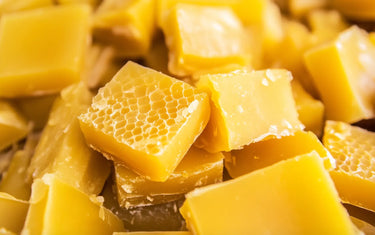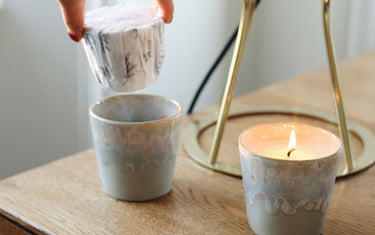5 min read / 15 May 2023 / Laura Garvin Gomez
How to Make a DIY Essential Oil Carpet Freshener
Create your own DIY essential oil carpet freshener for a naturally fresh and inviting home!
Share this post

Using a homemade carpet freshener is a great way to deodorise the fibres and remove any unpleasant odours.
Over time, all carpets pick up dirt and grime and emit bad smells that can’t be removed by simply vacuuming.
Essential oils are great at freshening carpet fibres and piles to help you get rid of these types of smells, without peppering your home with abrasive chemicals. Instead of using a commercial product, it allows you to naturally add a nose-pleasing fragrance that everyone can enjoy. Here we explain how easy it is to make an essential oil carpet freshener and much more.
What are the benefits of an essential oil carpet freshener?You may wonder what’s the point of using an essential oil carpet freshener when you can find a well-known commercial brand at the local supermarket. As is the case with other types of cleaners, cosmetics and a growing range of commercial products, people are becoming increasingly hesitant to expose themselves to harsh chemical ingredients. Whilst commercial brands must abide by regulatory guidelines, understanding what goes into making one remains a mystery to most people. Most products contain a mixture of baking soda, sodium silicate, calcium carbonate, and hydrated silica (sand), which are all harsh, abrasive substances. If you have sensitive skin or experience unexpected allergic reactions to some substances, this can happen with a commercial product. Especially as the fine grit in a freshener can be difficult to vacuum out of the carpet, so it can remain at the base of the carpet for quite some time. This can also accelerate wear and tear of the carpet fibre, as this grit rubs against the material as you walk across it. Deodorising carpet fibres with an essential oil mixture could offer a more natural alternative for your home. You know exactly what goes into making it, and if you are unsure about any allergies, you can always carry out a skin patch test to minimise the chances of experiencing an unexpected reaction. |
How to make a carpet freshener
To make your own carpet freshener spray you only need a few simple ingredients:
- Water
- Distilled white vinegar
- Essential oils
This mix does not include baking soda, as that is a main ingredient of many commercial products, and some experts believe it can cause damage to carpet fibres and vacuum cleaners.
White vinegar contains acetic acid that can help to cut through and break down dirt, greats and grime, whilst also combating bacteria. It also works as a natural deodoriser, so it is the perfect fit for a homemade freshener.
Follow the steps below to make a DIY carpet freshener:
- Use a spray bottle and mix some warm water and distilled vinegar together using a ratio of 1:1 (a cup of each should be enough to start with).
- Take your preferred essential oil and add 20-30 drops to the bottle.
- Replace the cap and mix the ingredients by shaking the bottle well.
Your carpet freshener is now ready for you to use – follow the instructions in the next section on how to spray it to your carpet.

How do I use an essential oil carpet freshener?
Once the mixture is ready, you can then prepare to sprinkle it over the carpet. Take the bottle and spray liberally over the carpet area. When you have finished, leave the carpet freshener to sit for a few hours or overnight, so it can dry thoroughly.
There are lots of recipes online that encourage you to use baking soda on your carpet, although this is not something we would advise. A white vinegar mixture will be kinder to your carpet, and it won’t leave behind any stains or signs of damage.
What are the best essential oils to use?
There is a huge range of essential oils to choose from, so to make things easier, we’ve narrowed down your options and selected some of the best below:
- Lavender essential oil can soothe and calm: Many people use lavender oil to relax and help them drift off to sleep at night. Lavender essential oil is calming and soothing and works very well as a freshener, with its anti-bacterial properties can help to cleanser the carpet too.
- Try the refreshing tones of ylang ylang: Ylang ylang essential oil has a wonderfully sweet and floral scent that is perfect for freshening up your carpet. It’s also a great relaxer, and the fragrance is known for being able to decrease heart rates, reduce anxiety and give you a pick-me-up, if needed.
- Rejuvenate the room with the fresh scent of lemon: The smell of lemon zest can create positive thoughts and feelings, helping to uplift moods and create a sense of calm. Adding lemon essential oil to a freshener also means your carpet can benefit from its antibacterial properties, helping to cleanse the fibres as well as layering them with a refreshing fragrance.

Are there any risks involved?
Essential oils are highly concentrated so you should always take care when handling them. Some people can experience allergic reactions that lead to skin irritation, redness or swelling, so if it is the first time you are using a particular oil, carry out a patch test.
A patch test simply involves adding one or two diluted drops (using a carrier oil) to the inside of your elbow and covering it with a plaster. Leave it for 24 hours and if there is no reaction, the oil should be fine to use. If you see redness, swelling or any form of irritation, do not use the oil in your spray.
If you have young children or own any pets, you should ensure they are kept away from the carpet freshener until it is dried. Some oils can be toxic for cats and dogs, and young children’s skin can be particularly sensitive to new substances in their early years.

The great thing about making your own DIY essential oil carpet freshener is that you know exactly what goes into making it. Unlike commercial brands that display a long list of chemicals that can be difficult to understand, you have more assurance that the carpet you walk on is not filled with potential irritants. Making your own freshener is something you can do without having to spend much money and it reduces the amounts of chemicals you and your family are exposed to at home, which can only be a good thing.









